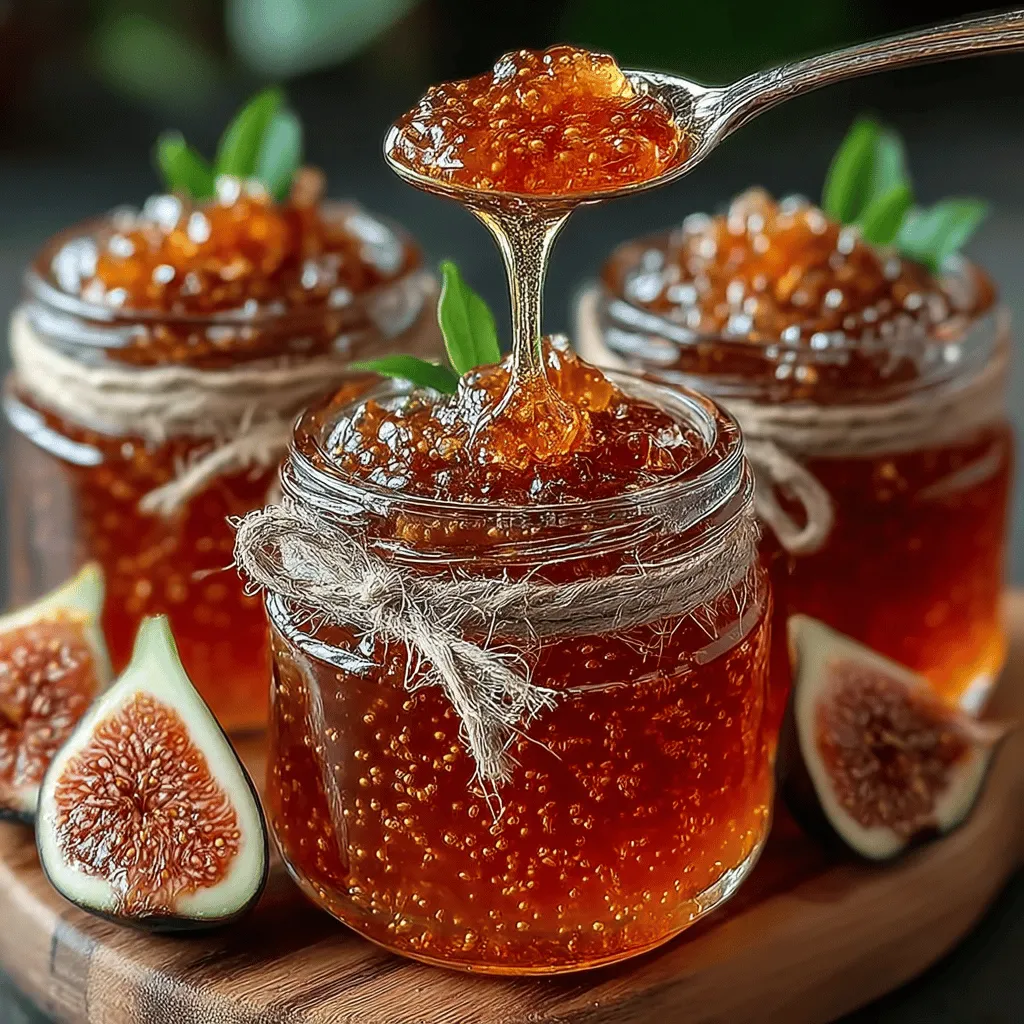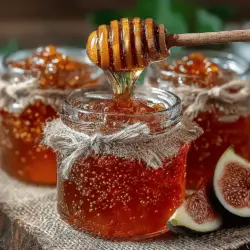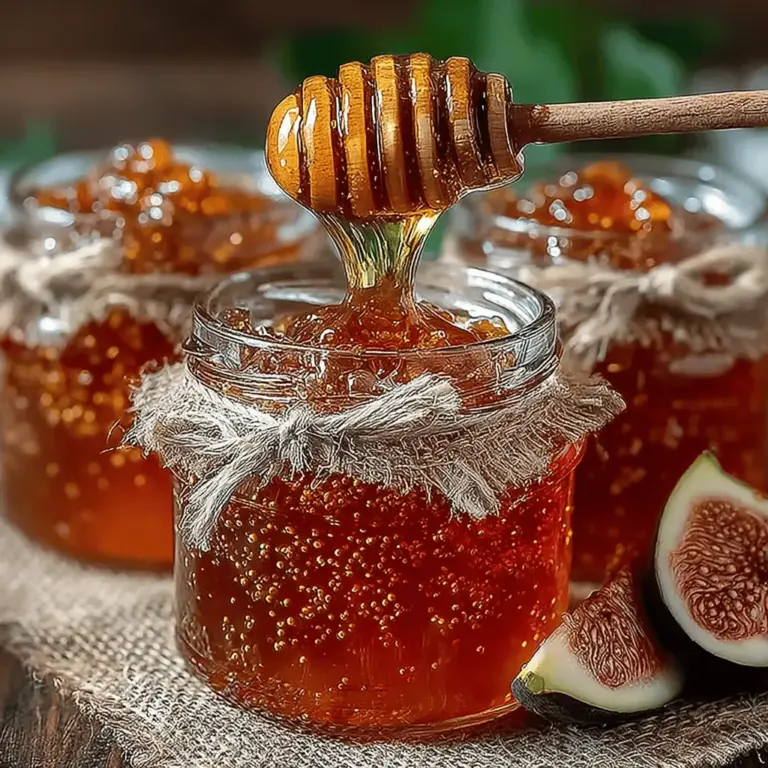Introduction
Fig jam has long enjoyed a place of honor in culinary traditions around the world, celebrated for its unique blend of sweet and savory flavors. This delectable spread is not only a treat for the taste buds but also a versatile ingredient that can elevate a variety of dishes. Whether slathered on a warm slice of bread, paired with cheese for an elegant appetizer, or used to liven up desserts, fig jam’s rich, complex taste makes it a favorite among food lovers and home cooks alike.
The beauty of making fig jam at home lies in its simplicity. With just a handful of ingredients, you can create a delightful spread that captures the essence of fresh figs. The art of preserving figs in this manner not only enhances their natural sweetness but also allows for the introduction of complementary flavors that can transform the humble fruit into something truly extraordinary.
In this article, we’ll guide you through the delightful process of making Sweet & Savory Fig Jam from scratch. We will delve into the ingredients that contribute to its unique flavor profile and provide step-by-step instructions for preparing this delicious jam.
Understanding the Ingredients
To create the perfect fig jam, it’s essential to understand the role of each ingredient in the recipe, starting with the star of the show: fresh ripe figs.
Fresh Ripe Figs
Figs are a fruit that boasts a rich history dating back thousands of years. They are not only delicious but also packed with nutritional benefits. Fresh figs are a great source of dietary fiber, vitamins, and minerals, including calcium, magnesium, and potassium. Their naturally sweet and slightly earthy flavor makes them an ideal candidate for jam-making. When selecting figs for your jam, it’s important to choose fresh, ripe ones that are slightly soft to the touch and have a rich color. Overripe figs can lead to a mushy texture, while underripe figs will lack the sweetness needed for a balanced jam.
Granulated Sugar
Sugar plays a dual role in the fig jam recipe. Primarily, it acts as a preservative, helping to extend the shelf life of the jam. It also enhances the natural sweetness of the figs, creating that delightful contrast between sweet and savory. The amount of sugar can be adjusted based on personal preference or the sweetness of the figs themselves. However, it’s essential to maintain a proper balance to ensure the jam sets correctly.
Lemon Juice
Lemon juice is another crucial ingredient in this recipe. It adds acidity, which brightens the overall flavor profile of the jam. The acidity from the lemon juice not only balances the sweetness of the figs and sugar but also helps in the preservation process. When cooking, the lemon juice assists in the gelling process, leading to a thicker consistency in the final product.
Salt
Though it may seem counterintuitive to add salt to a sweet jam, a pinch of salt enhances the flavors in the fig jam, bringing out the natural sweetness of the fruit. It acts as a flavor enhancer, allowing the nuanced taste of the figs to shine through while also creating a more rounded flavor profile.
Optional Flavorings
To elevate your fig jam to the next level, consider incorporating optional flavorings such as vanilla extract or cinnamon. Vanilla extract adds a warm, aromatic quality that complements the figs beautifully, while cinnamon introduces a hint of spice that can add depth to the jam. These additional ingredients can be adjusted according to your taste preferences, allowing you to craft a jam that is uniquely yours.
Preparation Steps for Fig Jam
Now that we’ve covered the essential ingredients, let’s move on to the preparation steps necessary for making your fig jam.
Preparing Fresh Figs
The first step in creating your fig jam is to prepare the fresh figs. Begin by washing the figs under cool running water to remove any dirt or impurities. Gently pat them dry with a clean kitchen towel to avoid bruising the delicate fruit.
Once the figs are clean, it’s time to remove the stems. Using a sharp knife, carefully cut off the stems, ensuring not to remove too much of the fruit itself. Next, quarter the figs by slicing them into four equal parts. This process will not only help them cook down more evenly but also create a beautiful texture in the final jam.
Importance of Using Fresh, Ripe Figs
Using fresh and ripe figs is crucial for achieving the best flavor and texture in your jam. Not only do ripe figs have a higher sugar content, which aids in the sweetness of the jam, but they also possess the soft, luscious quality that makes for a spreadable consistency. If you find yourself with figs that are slightly overripe or beginning to soften, don’t worry; these will work beautifully in your jam as well.
Combining Ingredients
Once your figs are prepared, it’s time to combine them with the other ingredients to create the base for your fig jam. In a large saucepan, combine the quartered figs with granulated sugar, fresh lemon juice, and a pinch of salt.
Step-by-Step Guidance
1. Measure Ingredients: For a basic fig jam, a good starting point is about 2 pounds of fresh figs, 1 cup of granulated sugar, the juice of one lemon, and a pinch of salt. Adjust the sugar based on your preference and the sweetness of the figs.
2. Mix Together: Gently stir the mixture in the saucepan until the figs are well-coated with sugar, salt, and lemon juice. This initial mixing is crucial as it helps the sugar dissolve and begins to draw out the natural juices from the figs.
3. Let it Sit: Allow the mixture to sit for about 30 minutes. This resting period gives the sugar time to extract moisture from the figs, creating a syrupy base that will form the foundation of your jam.
Cooking the Mixture
After the mixture has rested, it’s time to cook it down into a luscious jam. Place the saucepan on the stove over medium heat.
Transitioning from Medium Heat to Simmer
As the heat begins to activate the sugars and juices, you’ll notice the mixture starting to bubble. Stir the mixture frequently to ensure that it cooks evenly and prevents any sticking to the bottom of the pan. This initial phase typically takes about 10-15 minutes.
Importance of Stirring Frequently
Stirring is key during the cooking process. Not only does it help to prevent burning, but it also ensures that the figs break down evenly, contributing to a smooth texture. As the mixture begins to thicken, you’ll start to see the figs soften and release more juices, transforming into a beautiful jam-like consistency.
Simmering to Perfection
The final stage of cooking your fig jam involves a gentle simmer. Once the mixture reaches a rolling boil, reduce the heat to low and allow it to simmer. This is where the magic happens.
What to Look For as the Mixture Thickens
As the jam simmers, you’ll want to keep an eye on its consistency. It should gradually thicken, and you can test for doneness by placing a small spoonful on a plate and letting it cool for a moment. Run your finger through the jam; if it holds its shape and doesn’t immediately run back together, it’s ready to be removed from the heat.
Simmering typically takes anywhere from 30 to 45 minutes, depending on the amount of liquid in your figs and the desired thickness of your jam. Stir occasionally to ensure even cooking, and be prepared to adjust the heat as necessary to maintain a gentle simmer.
As you go through this process, the delightful aroma of cooking figs will fill your kitchen, making the anticipation of enjoying your homemade fig jam all the more exciting.
Stay tuned for the next part of this article, where we will explore the final steps in canning your Sweet & Savory Fig Jam, including tips on storage and serving suggestions.

Desired Consistency and How to Test It Effectively
Achieving the perfect consistency for your sweet and savory fig jam is crucial for a delightful spread. The desired texture should be thick enough to hold its shape when spread but not so thick that it becomes difficult to manage. A well-made fig jam should exhibit a glossy appearance and a luxurious mouthfeel.
Testing the Jam’s Consistency
One of the most effective methods to test the consistency of your jam is the cold plate method. Here’s how to do it:
1. Prepare the Cold Plate: Place a small plate in the freezer for about 10 minutes before you start cooking your jam.
2. Drop the Jam: When the jam reaches what you believe is the right cooking point (around 220°F or 104°C for high pectin fruits like figs), drop a spoonful of the jam onto the cold plate.
3. Tilt the Plate: After a minute, run your finger through the jam on the plate. If it holds its shape and the line stays clear, your jam is ready. If it runs back together, continue cooking and check again after a few minutes.
Patience is key in this process. Rushing might result in a jam that is either too runny or overly thick, which will not provide the ideal spreadable quality you desire for your toast, pastries, or cheese boards.
Enhancing Flavor with Optional Ingredients
To elevate the flavor profile of your fig jam, consider incorporating optional ingredients such as vanilla extract and cinnamon. These additions can deepen the sweetness and complexity of your jam, creating a more nuanced flavor that pairs beautifully with a variety of dishes.
Incorporating Vanilla Extract and Cinnamon
– When to Add: Add vanilla extract and ground cinnamon during the last few minutes of cooking to preserve their aromatic qualities. This timing ensures that their flavors infuse into the jam without being diminished by prolonged cooking.
– Balancing Flavors: The sweetness of figs pairs wonderfully with the warm notes of cinnamon and the rich, creamy undertones of vanilla. Start with a teaspoon of vanilla extract and a quarter teaspoon of cinnamon, adjusting based on your taste preferences. This balance can transform your fig jam from delicious to extraordinary.
These subtle enhancements can elevate your fig jam into a gourmet treat, making it a standout addition to any meal or snack.
Jarring the Jam
Once you have achieved the perfect consistency and flavor, it’s time to jar your fig jam. Following proper canning techniques will ensure that your jam remains fresh and safe to consume.
Step-by-Step Process of Transferring the Jam into Sterilized Jars
1. Sterilize Your Jars: Before you start jarring, make sure your jars are sterilized. This can be done by boiling them in water for 10 minutes or running them through a dishwasher cycle on high heat.
2. Fill the Jars: Using a ladle, carefully pour the hot jam into the sterilized jars. Leave about ¼ inch of headspace at the top of each jar. This space is crucial for creating a vacuum seal and preventing the jam from overflowing during processing.
3. Clean the Jar Rims: After filling, wipe the rims of the jars with a clean, damp cloth to remove any residue. This step is vital for ensuring a proper seal.
Sealing and Storing Your Fig Jam
Proper sealing and storage are essential to enjoy your fig jam for months to come.
Guidance on Sealing Jars Correctly
1. Place the Lids: Center the sterilized lids on top of the filled jars.
2. Secure the Bands: Screw the metal bands onto the jars until they are fingertip-tight. Avoid over-tightening, as this can hinder the vacuum seal process.
3. Cool Before Refrigeration: Allow the jars to cool completely at room temperature before transferring them to the refrigerator. This cooling process helps to create a strong vacuum seal.
Storage Options: Refrigeration vs. Water Bath Processing
– Refrigeration: If you plan to use your fig jam within a few weeks, simply store the sealed jars in the refrigerator. Homemade fig jam can last for up to three weeks when refrigerated.
– Water Bath Processing: For long-term storage, consider processing your jars in a boiling water bath. This method involves submerging the sealed jars in boiling water for at least 10 minutes to create a vacuum seal. Properly processed jars can be stored in a cool, dark place for up to a year.
Serving Suggestions for Fig Jam
Fig jam is incredibly versatile and can enhance both sweet and savory dishes. Here are some creative ways to enjoy your homemade fig jam:
1. Pairing with Cheese: Serve fig jam with a cheese platter, pairing it with creamy cheeses like Brie, tangy goat cheese, or sharp cheddar. The sweet and savory notes of the jam complement the richness of the cheese beautifully.
2. Spread on Toast: Use fig jam as a delightful spread on toasted bread or bagels, perhaps with a slather of cream cheese for added indulgence.
3. In Desserts: Incorporate fig jam into desserts by swirled into yogurt, as a filling for pastries, or even drizzled over ice cream. The rich flavor can elevate any dessert to new heights.
4. Savory Dishes: For a unique twist, use fig jam as a glaze for meats like pork or chicken. Its sweetness can balance savory spices and enhance the overall flavor of the dish.
5. Salad Dressing: Whisk fig jam into salad dressings for a sweet and tangy flavor that pairs perfectly with greens and roasted vegetables.
Culinary Benefits of Homemade Fig Jam
Making your own fig jam offers numerous benefits over store-bought options.
Flavor Customization and Absence of Preservatives
– Tailored Flavor Profiles: When you make fig jam at home, you have complete control over the ingredients. You can adjust the sweetness, spice level, and overall flavor to suit your personal preferences. This customization is particularly valuable for those with dietary restrictions or specific taste profiles.
– No Preservatives: Homemade fig jam allows you to avoid artificial preservatives and additives commonly found in store-bought versions. This means you can enjoy a natural product made from fresh ingredients, giving you peace of mind about what you’re consuming.
Making fig jam at home is not only a rewarding culinary experience, but it also results in a delicious product that showcases the natural flavors of the ingredients.
Conclusion
Creating your own sweet and savory fig jam is a delightful endeavor that brings together the vibrant flavors of fresh figs and optional enhancements like vanilla and cinnamon. With the proper techniques for testing consistency, jarring, and sealing, you can enjoy your homemade jam for months to come.
Remember to experiment with serving suggestions—whether it’s pairing it with cheese, incorporating it into desserts, or using it as a glaze for savory dishes. The joy of making and sharing your fig jam with friends and family is unparalleled, and the satisfaction of knowing exactly what goes into your food enhances the whole experience. Connect with your culinary creativity, and let your homemade fig jam be a sweet addition to your kitchen repertoire.

